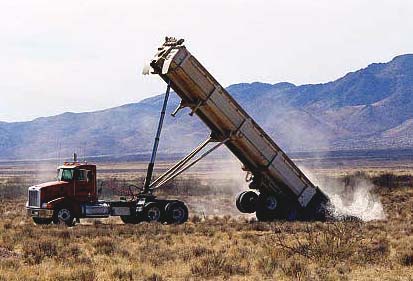
Wednesday, March 22, was a busy day at the site. First, a hole was dug to accommodate a 1200-gallon septic tank. This hole was then inspected by the New Mexico Environment Department. Upon approval, the tank was placed in the hole and carefully levelled.
Meanwhile, the NMED representative did a soil inspection and determined how long the leach line needed to be. Unfortunately, the septic tank sits in a deep layer of pure clay soil. If I wanted to build an adobe house, I'd have no problem making some of the best bricks in the county. But what it means for the septic system is that I have to run three 100-foot-long leach lines. Since the trenches must be 5' deep, and then filled with 3' of rock, that means lots of backhoe time and lots of rock.
Three hundred feet of trenching takes time in this hard soil; the work wasn't completed until Monday. After dumping the rock into the trench, the pipe was laid in and levelled; then the trenches were filled with dirt to grade level. Finally, after carefully marking the spot so we can hook up to it later, the tank was buried.

OK, so let's figure this out. Three feet of rock in each of the trenches, which are two feet wide and 100' long. That's 600 cubic feet of rock per trench, for a total of 1,800 cubic feet. The translation is that it took four of these big trucks to bring in all that rock, and there ain't much rock left over. This was a lot bigger job than was anticipated.

And here's the object of all that labor - one large reinforced-concrete
box, lovingly set into place and meticulously levelled. Beyond, you can
see the pipe running to a three-way distribution box, which will send the
liquid out to the three leach lines.
Next up: RV Parking
The TRF Housing Tract Home Page
Terry R. Friedrichsen
terry@venus.sunquest.com